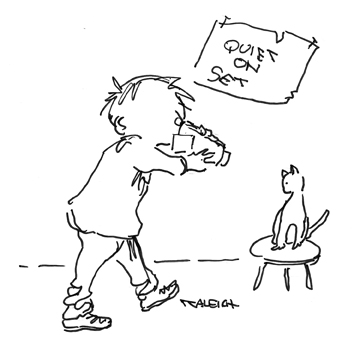Film: Offhand Filmmaking
By Henry P. Raleigh
ART TIMES Nov/ Dec 2012
 |
In 1958 New York art society insiders were treated to an amateur film title “Pull My Daisy”. Created by Robert Frank and Al Leslie it featured art celebrities as Allen Ginsberg, Jack Kerouac, and Larry Rivers. Funny outrageous, over-the-top the film did not pretend to be anything more than that. Warhol’s “home moves” followed in the 60’s. By the late 70’s there emerged a short-lived movement in filmmaking (after the 50’s nearly every movement in art was short lived) known loosely as New York Underground film. Centered largely in the city’s Lower East Side and, if not influenced by, at least accompanied, those days of protest that marked the decades. Anti just about everything including the movie making establishment and filmmaking itself, its creative tool was the Super 8 and 16mm. camera, its products works that looked much like those grainy, jittery 8mm. films of your high school graduation. These films were a kind of celebration of amateurism, deliberately so — improvised narrations, on the fly recording of gritty life of artists and musicians of that time and place. Made on the cheap, expecting no return, this was Art, true, honest, authentic. Out of this mix would come filmmakers that would become better known to a wider audience of film goers— among these Susan Seidelman (“Smithereens” 1982), Jim Jarmushche (“Stranger than Paradise” 1984), actor Steve Buscemi, and actor/musician John Lurie.
Shift now to the present and a film movement, as it has begun to be labeled, called “found footage film.” This designation, still young enough to still appear in the lower case letters, is alone of interest for it suggests a spontaneous recording of an unrehearsed event— as good a definition of the New York Underground Film as any but the resemblance of the two movements ends there for “found footage” is all make-believe. Imagine yourself in an unusual situation, a really hot party, for example, and there, almost forgotten is a camcorder stuffed in your back pocket so why not take it out and use it for something? Later it gets tossed in your dresser drawer or maybe parts of it, just for kicks, wind up on the internet. Before you can say “box office smash” the film is discovered and you are rolling in big money. How big you ask? The found footage film “Blaire Witch Project” made $260 million in 1999, “Paranormal Activity” $108 million in 2009, “Cloverfield” $80 million in 2008, and at this writing “The Devil Inside” and “Project X” are still out there pulling in cash.
The less flattering term for what could be a budding new genre is faux documentary of “mock-doc”. Russ Hexter’s “Dadetown” in 1996 was a classic faux documentary, so slick and so well executed it could fool anyone and at the same time bore some uncomfortable social truths. Art making, originality, sub-text of meaning are not strong suits in “found footage films”. The sole reference to authenticity lies in its documentary pretensions seemingly validated by the bouncing, careening, single-point-view, hand-held camera. Film plots are pretty much “found” too. “Blaire Witch” and “Paranormal” are like every B ghost film you’ve ever seen: “Cloverfield” distinguishes itself from “ The beast From 20,000 Fathoms” and “Godzilla, King of the Monsters” and their progeny only by a different monster.
And for purportedly off-hand, no frills filmmaking “found footage” is inexpensive only by Hollywood production standards. “Blair Witch” had a reported budget of $500,000, “Paranormal” $15,000, “Cloverfield” $425-30 million, “Project X” $12 million. “Finding film footage is apparently the easy part, finding the money must be trickier. However, it is rumored that the large film studio have taken notice of this cost factor— high priced actors, inflated budgets and a steady falling off of movie attendance does lend this new genre an attractiveness. And if the public doesn’t mind being gulled by moc-docs so be it— professional wrestling gets away with it, right?
